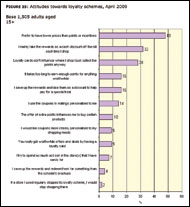 It takes a lot for Brits to switch retailers as new research from Mintel finds just 4% of us have taken the plunge, switching our main grocery store in the past year. The research finds, despite tough economic conditions, grocery discounters are not replacing the use of mainstream retailers, as there is little evidence of people changing their main grocery store.
It takes a lot for Brits to switch retailers as new research from Mintel finds just 4% of us have taken the plunge, switching our main grocery store in the past year. The research finds, despite tough economic conditions, grocery discounters are not replacing the use of mainstream retailers, as there is little evidence of people changing their main grocery store.
But food price inflation and the recession are having an impact on grocery shopping, and consumers are becoming increasingly aware of prices and promotions whether they have been affected directly by the recession or not. Indeed, today some 54% of shoppers are buying more food on special offers and multibuys, while over a third (36%) are trading down and buying more budget own-brands. One in five (21%) is buying more from discount grocers such as Aldi and Lidl and nearly three in ten (28%) have also cut back on treats and luxuries.
And it is not only those on a tighter budget who are making cut-backs. A high number of affluent families are also watching the pennies. Nearly four in ten (38%) of these better off families are now buying more budget own-brands and 21% are spending more in grocery discounters.
Meanwhile, participation in loyalty card schemes is at an all time high and loyalty schemes now attract more shoppers than ever. Today, almost three quarters of Brits (73%) use one or more cards, up from 65% in 2006. Just 28% of adults state that cards have no influence on where they shop, and that they simply collect points on offer and only 7% of adults aim to spend as much as they can in stores they have cards for. In addition, just 2% say that they would stop using a store if it stopped its loyalty scheme, which is indicative that loyalty cards have very little influence on where people shop and how much they spend with retailers.
It is not only grocery stores where consumers are looking for discounts. Discount and value non-food retailers are also benefiting, although the extent of down-trading in clothing is less marked, with just 14% of adults stating that they are now spending more in cheaper fashion stores. Smarter shopping is certainly in evidence in non grocery stores too, with 20% shopping around more for the lowest price on major purchases, 14% waiting for the Sales before buying and 21% comparing prices on the internet before buying.




Comments are closed.